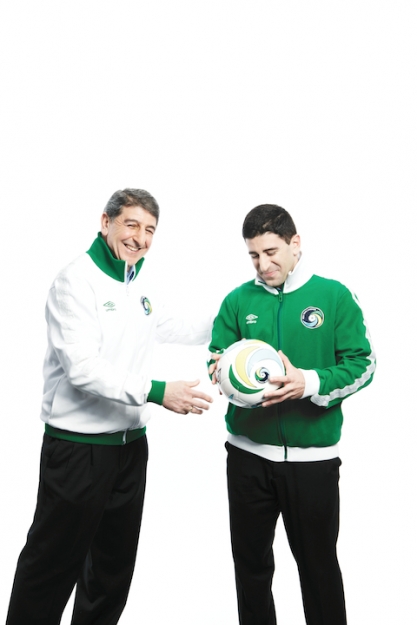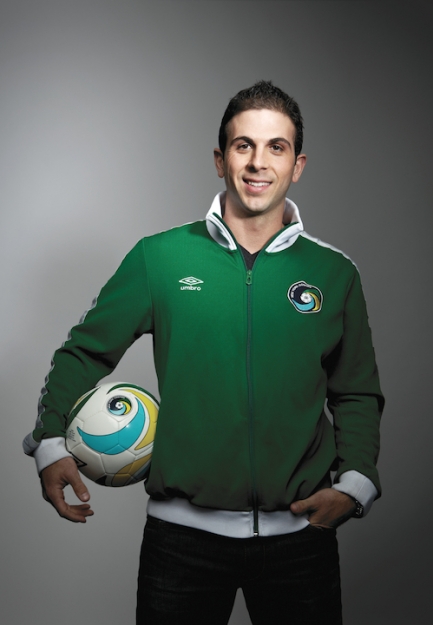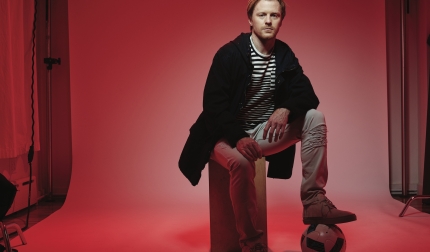Once upon a time, in a land not so far away, one of the world’s most popular soccer teams played not in England, nor Brazil, but in East Rutherford, NJ. The team was made up of several World Cup champions and international superstars who came to America to grow the game in the world’s biggest market. The roster of names—Pelé, Franz Beckenbauer, Giorgio Chinaglia, Carlos Alberto—read like a team of world All-Stars. And for a few years in the late 1970s, they were the rock stars of soccer. And then professional soccer in the United States imploded. But from those ashes, the Cosmos rise again.
With plans for a new stadium drawn up and a legion of fans ready to take their Cosmos gear out of storage, the mighty franchise has joined the re-formed North American Soccer League with a great optimism for the future. “I was born here in the United States because of the Cosmos,” says Alecko Eskandarian, a former MLS and US National Team star who is now a coach with the new Cosmos. It allowed my dad to move here. The whole prestige of playing for the team was unheard of, and it has never been duplicated. Our goals with the Cosmos are big. I want my dad’s generation to look at what we are doing and be proud. That is my hope.”
Eskandarian’s dad is Andranik Eskandarian, a legendary defender who played for the Iranian World Cup team in 1978. At the time, the head of Warner Communications, Steve Ross, was assembling a super team. Ross started by convincing Pelé, the greatest player in the history of the game, to come out of his early retirement and help grow the sport in America. When Pelé signed, he became the highest-paid athlete in the world.
From there, the Cosmos would lure Giorgio Chinaglia, the star of Italy’s Lazio team who was in the prime of his career. They would add Franz Beckenbauer, one of the greatest sweepers in the game and captain of West Germany’s World Cup winning team. They also added Carlos Alberto, captain of the Brazilian national team. Coming to the Cosmos, “was one of the best decisions I have ever made,” said Franz Beckenbauer in an incredible documentary on the Cosmos titled Once in a Lifetime.
The team was playing to crowds of over 70,000 people in a then brand new Giants Stadium. But Ross and his executives were still constantly on the lookout for the best foreign talent that they could import. When they spotted Andranik Eskandarian at a US tournament, they pounced.
“I came to the United States to play in a tournament,” Andranik says. “Steve Ross asked me if I wanted to stay and play for the Cosmos. I didn’t know what to say. Ross said, “Think about it, come back tomorrow.” After some soul-searching, Eskandarian decided to stay in the United States and give the Cosmos a try. “It was one of the best decisions of my life,” he says. “Every memory was a good memory. When I walked in the locker room, there were 14 different nationalities and none of us spoke good English!”
International soccer stars weren’t the only people in the locker room. Thanks to Ross’ entertainment and business connections, the players had no idea which superfan would show up to the game and greet them afterward. Former Secretary of State Henry Kissinger never missed a game. Barbara Streisand and Robert Redford made appearances. And once, a security guard tried to escort a scrawny disheveled British man from the player’s area, unsure of who he was. It turned out to be Mick Jagger.
The team became a worldwide sensation. Ross took the team on road trips so the rest of the world could see the incredible aggregation of talent. One Far East road trip took the team throughout Hong Kong, Korea and Japan, playing 18 games in 45 days. And as quickly as the team’s fortunes rose, they quickly descended, as a perfect storm of factors conspired to wipe out the NASL. Rapid expansion took the league to 24 teams, many in cities that could not support a soccer team. In an effort to keep up with the Cosmos, some franchises invested millions in aging players that did not bring the cachet or performance value that the Cosmos’ acquisitions did. When games received lackluster ratings on ABC, the network scrapped the sport. Many attributed the poor ratings to the games being played on early Saturday afternoons in the summer, a time when families were enjoying the outdoors.
The Cosmos themselves fell on hard financial times. With their stake in Atari video games plummeting along with the gaming market, Warner Communications was forced to divest their stake in money-losing ventures, including American soccer. Without the backing of Warner, the team could no longer afford the high salaries to lure talent away from European teams. When FIFA decided not to place the 1986 World Cup in the United States, opting for Mexico instead, the air in America’s soccer balloon deflated.
Despite the meteoric rise and fall of the league, millions of people still have fond memories of the Cosmos, and they are ready for a comeback. In 2010, the Cosmos brand was relaunched. Many thought it would be a natural fit for burgeoning Major League Soccer.
In August, the new look Cosmos will take the field for the first time in a very familiar place. They will play their home games at Hofstra University, where the team played home games nearly forty years ago. Several MLS veterans will be taking the field wearing the Cosmos’ green and white, including Carlos Mendes, a Mineola, NY native who grew up just a few miles from Hofstra. Mendes, a veteran with over 140 games as a member of the New York Red Bulls on his resume, is looking forward to the challenge of launching the new franchise.
“My parents came to the United States from Portugal, and they went to Cosmos games,” Mendes said. “I grew up hearing the name and stories to go with it. Some of the greatest players in the world were right here and hopefully we can bring it back to that level. In my mind it all seems very magical – growing up and seeing those videos of the great Cosmos teams.” Mendes talked at great length about growing up on Long Island and how important soccer has been to the fabric of the community.
“I’ve been playing as a professional for nine, 10 years now in this area,” he said. “And I can feel the passion. There’s so much soccer being played here in this area. I feel very lucky to have this opportunity right in my backyard. This is a golden opportunity. It’s an exciting market overall, which is getting stronger and growing.”
While many expected the Cosmos to join Major League Soccer, the $100 million expansion fee seemed like an obstacle that was both prohibitive and unnecessary, particularly while the franchise needs to line up another $200 million for their stadium plan. Instead, the team has joined the re-born NASL, which now has a dozen teams. The Cosmos will play a 14-game season this year, beginning in August.
With the new season, the Cosmos legacy continues. “When the Cosmos ended, it was like a part of my body was taken away,” says Andranik Eskandarian. “To see them come back to play, to see my son Alecko as a coach, it’s like a second dream come true.”







